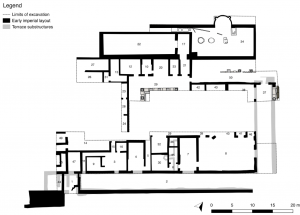
Historical Summary of the Vacone Villa
The Upper Sabina Tiberina Project has excavated the Roman villa of Vacone since 2012, revealing an extensive late-Republican through mid-Imperial multi-phase villa, measuring 62 x 46 meters in total, with an elaborately decorated residential area and large agricultural production area. The villa is situated on a l arge, artificial terrace constructed in the mid to late second century BC. The terrace is formed by an L or U-shaped arrangement of vaulted cryptoporticoes built into the bedrock of the mountain in order to support the villa. A large cistern is situated at the rear of the terrace, also dating from the mid to late second century BC. While the first phase of the villa was constructed in the Republican period, the entire structure seems to have been renovated around the time of Augustus. This early Imperial renovation included the rearrangement of rooms and the installation of new floors and walls. To date, we have identified approximately forty rooms belonging to the imperial phase villa, including a central peristyle with a 5 x 5 columnar arrangement, a series of reception rooms opening onto the south-eastern colonnaded portico, along with additional reception rooms in the back of the villa, bedrooms, and work spaces. We have at least 30 mosaic floors preserved today, including some 16 polychrome mosaics and seven bi-chrome mosaics (both black and white and red and white patterns), along with significant amounts of in-situ painted plaster on the surviving walls. The villa décor demonstrates significant wealth and investment in the rural residence to match the fashions current across Italy during the early imperial period, as the decorative patterns of the mosaics in particular are paralleled at numerous contemporary sites across Italy.
arge, artificial terrace constructed in the mid to late second century BC. The terrace is formed by an L or U-shaped arrangement of vaulted cryptoporticoes built into the bedrock of the mountain in order to support the villa. A large cistern is situated at the rear of the terrace, also dating from the mid to late second century BC. While the first phase of the villa was constructed in the Republican period, the entire structure seems to have been renovated around the time of Augustus. This early Imperial renovation included the rearrangement of rooms and the installation of new floors and walls. To date, we have identified approximately forty rooms belonging to the imperial phase villa, including a central peristyle with a 5 x 5 columnar arrangement, a series of reception rooms opening onto the south-eastern colonnaded portico, along with additional reception rooms in the back of the villa, bedrooms, and work spaces. We have at least 30 mosaic floors preserved today, including some 16 polychrome mosaics and seven bi-chrome mosaics (both black and white and red and white patterns), along with significant amounts of in-situ painted plaster on the surviving walls. The villa décor demonstrates significant wealth and investment in the rural residence to match the fashions current across Italy during the early imperial period, as the decorative patterns of the mosaics in particular are paralleled at numerous contemporary sites across Italy.
At least part of this wealth was surely generated through agricultural activity at the villa. Our excavations have revealed an olive oil production facility with at least four circular press beds, three settling tanks, and a bottling room. Sabine olive oil was valued for its quality in antiquity (as it is today), and this is one of the largest extant oil production facilities in central Italy, and is clearly indicative of export-oriented production. The agricultural life of the villa was dynamic and responsive to wider economic demands on the region, and eventually diversified its focus to include wine production. This change probably happened during the second century AD and occurred at the expense of the majority of the olive oil production. The villa seems to have been abandoned by the early third century AD, possibly as the result of an earthquake or some other subsidence event, as we have found a number of instances of damage to the villa with haphazard repairs that date to this period. Many repairs were left unfinished as the site was simply abandoned.
After the end of occupation in the Roman period, we have little evidence for activity until the early medieval period. During this hiatus in site use, the villa collapses, leaving scant remnants of its former glory aside from the standing structures of the terrace and cistern. Activity resumes on the site during the Lombard era, as evidenced by several burials dating between the seventh and eight centuries AD. There is as of yet no sure evidence for site occupation at this time, so the exact nature of settlement in early medieval Vacone is still to be clarified. After the Lombard era, it seems that the standing structures were used for shelter and probably for keeping animals during the medieval period, while the main terrace of the villa had a number of agricultural planting trenches dug through it from the fifteenth or sixteenth century onwards.
The site was used for agricultural purposes until its archaeological rediscovery in the second half of the twentieth century, and the Roman remains unearthed by agricultural activity over these centuries contributed to the antiquarian tradition that the site belonged to the Roman poet Horace, known to have kept a villa in the Sabine region. We have no evidence that the villa of Vacone ever actually belonged to Horace, but our excavations certainly suggest that one of his wealthy contemporaries made a good living in the rural Sabina and left behind a rich archaeological legacy.